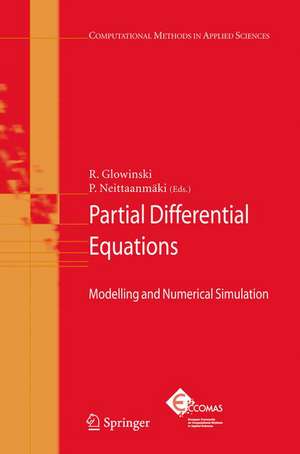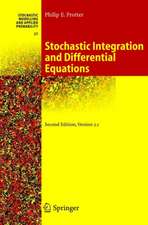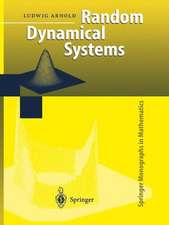Partial Differential Equations: Modelling and Numerical Simulation: Computational Methods in Applied Sciences, cartea 16
Editat de Roland Glowinski, Pekka Neittaanmäkien Limba Engleză Hardback – 7 iul 2008
| Toate formatele și edițiile | Preț | Express |
|---|---|---|
| Paperback (1) | 999.60 lei 6-8 săpt. | |
| SPRINGER NETHERLANDS – 25 noi 2010 | 999.60 lei 6-8 săpt. | |
| Hardback (1) | 1005.74 lei 6-8 săpt. | |
| SPRINGER NETHERLANDS – 7 iul 2008 | 1005.74 lei 6-8 săpt. |
Din seria Computational Methods in Applied Sciences
- 15%
 Preț: 655.27 lei
Preț: 655.27 lei - 15%
 Preț: 651.51 lei
Preț: 651.51 lei - 15%
 Preț: 657.73 lei
Preț: 657.73 lei - 5%
 Preț: 709.87 lei
Preț: 709.87 lei - 18%
 Preț: 1116.26 lei
Preț: 1116.26 lei - 18%
 Preț: 947.35 lei
Preț: 947.35 lei - 18%
 Preț: 1224.54 lei
Preț: 1224.54 lei - 18%
 Preț: 952.89 lei
Preț: 952.89 lei - 18%
 Preț: 947.35 lei
Preț: 947.35 lei - 20%
 Preț: 653.38 lei
Preț: 653.38 lei - 18%
 Preț: 954.45 lei
Preț: 954.45 lei - 15%
 Preț: 638.76 lei
Preț: 638.76 lei - 20%
 Preț: 648.59 lei
Preț: 648.59 lei - 18%
 Preț: 954.45 lei
Preț: 954.45 lei - 20%
 Preț: 640.19 lei
Preț: 640.19 lei - 18%
 Preț: 1231.16 lei
Preț: 1231.16 lei - 24%
 Preț: 789.37 lei
Preț: 789.37 lei - 18%
 Preț: 946.41 lei
Preț: 946.41 lei - 20%
 Preț: 567.63 lei
Preț: 567.63 lei - 15%
 Preț: 639.25 lei
Preț: 639.25 lei - 18%
 Preț: 952.57 lei
Preț: 952.57 lei - 15%
 Preț: 636.80 lei
Preț: 636.80 lei - 15%
 Preț: 650.69 lei
Preț: 650.69 lei - 18%
 Preț: 952.26 lei
Preț: 952.26 lei - 18%
 Preț: 1239.99 lei
Preț: 1239.99 lei - 5%
 Preț: 716.65 lei
Preț: 716.65 lei
Preț: 1005.74 lei
Preț vechi: 1226.52 lei
-18% Nou
Puncte Express: 1509
Preț estimativ în valută:
192.44€ • 200.95$ • 158.92£
192.44€ • 200.95$ • 158.92£
Carte tipărită la comandă
Livrare economică 15-29 aprilie
Preluare comenzi: 021 569.72.76
Specificații
ISBN-13: 9781402087578
ISBN-10: 1402087578
Pagini: 312
Ilustrații: XVI, 292 p.
Dimensiuni: 155 x 235 x 23 mm
Greutate: 0.61 kg
Ediția:2008
Editura: SPRINGER NETHERLANDS
Colecția Springer
Seria Computational Methods in Applied Sciences
Locul publicării:Dordrecht, Netherlands
ISBN-10: 1402087578
Pagini: 312
Ilustrații: XVI, 292 p.
Dimensiuni: 155 x 235 x 23 mm
Greutate: 0.61 kg
Ediția:2008
Editura: SPRINGER NETHERLANDS
Colecția Springer
Seria Computational Methods in Applied Sciences
Locul publicării:Dordrecht, Netherlands
Public țintă
ResearchCuprins
Discontinuous Galerkin and Mixed Finite Element Methods.- Discontinuous Galerkin Methods.- Mixed Finite Element Methods on Polyhedral Meshes for Diffusion Equations.- On the Numerical Solution of the Elliptic Monge—Ampère Equation in Dimension Two: A Least-Squares Approach.- Linear and Nonlinear Hyperbolic Problems.- Higher Order Time Stepping for Second Order Hyperbolic Problems and Optimal CFL Conditions.- Comparison of Two Explicit Time Domain Unstructured Mesh Algorithms for Computational Electromagnetics.- The von Neumann Triple Point Paradox.- Domain Decomposition Methods.- A Lagrange Multiplier Based Domain Decomposition Method for the Solution of a Wave Problem with Discontinuous Coefficients.- Domain Decomposition and Electronic Structure Computations: A Promising Approach.- Free Surface, Moving Boundaries and Spectral Geometry Problems.- Numerical Analysis of a Finite Element/Volume Penalty Method.- A Numerical Method for Fluid Flows with Complex Free Surfaces.- Modelling and Simulating the Adhesion and Detachment of Chondrocytes in Shear Flow.- Computing the Eigenvalues of the Laplace-Beltrami Operator on the Surface of a Torus: A Numerical Approach.- Inverse Problems.- A Fixed Domain Approach in Shape Optimization Problems with Neumann Boundary Conditions.- Reduced-Order Modelling of Dispersion.- Finance (Option Pricing).- Calibration of Lévy Processes with American Options.- An Operator Splitting Method for Pricing American Options.
Textul de pe ultima copertă
This book is dedicated to Olivier Pironneau.
For more than 250 years partial differential equations have been clearly the most important tool available to mankind in order to understand a large variety of phenomena, natural at first and then those originating from human activity and technological development. Mechanics, physics and their engineering applications were the first to benefit from the impact of partial differential equations on modeling and design, but a little less than a century ago the Schrödinger equation was the key opening the door to the application of partial differential equations to quantum chemistry, for small atomic and molecular systems at first, but then for systems of fast growing complexity.
Mathematical modeling methods based on partial differential equations form an important part of contemporary science and are widely used in engineering and scientific applications. In this book several experts in this field present their latest results and discuss trends in the numerical analysis of partial differential equations. The first part is devoted to discontinuous Galerkin and mixed finite element methods, both methodologies of fast growing popularity. They are applied to a variety of linear and nonlinear problems, including the Stokes problem from fluid mechanics and fully nonlinear elliptic equations of the Monge-Ampère type. Numerical methods for linear and nonlinear hyperbolic problems are discussed in the second part. The third part is concerned with domain decomposition methods, with applications to scattering problems for wave models and to electronic structure computations. The next part is devoted to the numerical simulation of problems in fluid mechanics that involve free surfaces and moving boundaries. The finite difference solution of a problem from spectral geometry has also been included in this part. Inverse problems are known to be efficient models used in geology, medicine, mechanics andmany other natural sciences. New results in this field are presented in the fifth part. The final part of the book is addressed to another rapidly developing area in applied mathematics, namely, financial mathematics. The reader will find in this final part of the volume, recent results concerning the simulation of finance related processes modeled by parabolic variational inequalities.
For more than 250 years partial differential equations have been clearly the most important tool available to mankind in order to understand a large variety of phenomena, natural at first and then those originating from human activity and technological development. Mechanics, physics and their engineering applications were the first to benefit from the impact of partial differential equations on modeling and design, but a little less than a century ago the Schrödinger equation was the key opening the door to the application of partial differential equations to quantum chemistry, for small atomic and molecular systems at first, but then for systems of fast growing complexity.
Mathematical modeling methods based on partial differential equations form an important part of contemporary science and are widely used in engineering and scientific applications. In this book several experts in this field present their latest results and discuss trends in the numerical analysis of partial differential equations. The first part is devoted to discontinuous Galerkin and mixed finite element methods, both methodologies of fast growing popularity. They are applied to a variety of linear and nonlinear problems, including the Stokes problem from fluid mechanics and fully nonlinear elliptic equations of the Monge-Ampère type. Numerical methods for linear and nonlinear hyperbolic problems are discussed in the second part. The third part is concerned with domain decomposition methods, with applications to scattering problems for wave models and to electronic structure computations. The next part is devoted to the numerical simulation of problems in fluid mechanics that involve free surfaces and moving boundaries. The finite difference solution of a problem from spectral geometry has also been included in this part. Inverse problems are known to be efficient models used in geology, medicine, mechanics andmany other natural sciences. New results in this field are presented in the fifth part. The final part of the book is addressed to another rapidly developing area in applied mathematics, namely, financial mathematics. The reader will find in this final part of the volume, recent results concerning the simulation of finance related processes modeled by parabolic variational inequalities.
Caracteristici
Covers a wides spectrum of topics related to the numerical solution of partial differential equations Serves as state-of-the-art reference for the scientist or practitioner solving problems in science of engineering described by partial differential equations











